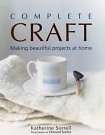I don't know what happened to the time, but I meant to blog this little project for soy candles weeks ago...
Like a lot of crafty people, I dabbled with candlemaking as a child, but somehow it never really captivated me as a craft. I think the crux of the problem was that I always tended to use those kits involving smelly, flakey paraffin wax that had to be mixed with stearin and then set within unforgiving plastic moulds using lurid artificial colours and fragrances.
It was only recently that I became inspired to give it another go... largely thanks to
this post on the iMake blog, which sold me on the idea of beautiful container candles made with soy wax... a vast improvement on paraffin wax. The urge was helped along further by my revival of interest in soapmaking... (lets face it - once I'd got all of my essential oils out of hibernation, scented candles became something of an inevitability.)
So here are my candles - and I have to say I am very pleased with them!
I made a batch of these one Sunday afternoon with a friend and we chose the scent combinations together, as a result of the
blending experiments that I discussed here. We decided to scent half of them with a very pleasing combination of Sweet Orange, Ylang Ylang and Cinnamon essential oils and the rest with a fresh, foresty combination of Lavender, Peppermint and Rosemary. The orange-based ones are real crowd-pleasers and do wonders to generate a feel-good scent into the room, whereas the foresty ones have a cleansing, freshening property and would be ideal to burn around the house after a good spring clean.
Overall this project was very quick and easy indeed and barely needs any explanation. So the rest of this post is a series of comments on the ingredients and equipment used - along with some personal thoughts about scenting, in case anyone out there fancies giving it a go.
In terms of equipment, you don't really need a great deal of stuff. First you need some kind of containers - and a great place to find these is charity shops. I managed to find some ideal bits and bobs of glassware, which suited me just fine.
And of course you need some wax. I ordered some lovely organic soy wax from
The Soap Kitchen and found it much easier to work with than paraffin wax. It is much softer and less brittle in texture and it melted very easily in a glass jug over warm water. It also washed easily out of the jug, simply using washing up liquid and hot water. (I suspect, for anyone who finds soy wax to be
too soft, that it could be tempered by mixing in a few beeswax pellets to add hardness.)
As for the rest of the bits - the main thing you need is some wick, which can be got from any online candlemaking supplier. For container candles, the only advice I'd offer is to choose your containers first and then purchase wicks that are of an appropriate gauge (or thickness) for the diameter of your containers. Personally, I went for a very easy option and bought ready-made lengths of stiffened wick, attached to little metal holders at the bottom. I used a tiny blob of special wax glue to attach the wick holder to the bottom of the container (but if that all sounds a bit much, there are plenty of online tutorials for sealing your wick into the bottom of the container simply by bending the end and using a bit of melted wax).
An optional extra which I found very useful was a pair of skewers held together at both ends with rubber bands, which you can lay along the rim of the container and use to trap your wick so that it is held perfectly stiff and upright when you come to pour in the wax. You can see the general idea here, as my candles were setting...
Finally.... depending on your whim, you might want to add some scent and colour. If adding essential oils, you want to do this as late as possible, after the wax has melted but not if it is piping hot. Let it cool as much as possible without re-setting and then bung in your essential oils and get it quickly mixed just before pouring. (This is mainly to prevent the precious scents from evaporating in a mass of aromatic steam).
My personal preference was to keep the colour natural, but to scent the candles
thoroughly with essential oils. When I say 'thoroughly', lets just say that I am no stranger to spending crazy money on the sort of beautiful container candles made by brands like Diptyque... so I was looking to emulate this sort of high-quality product for a lot less money. And this is where I bothered to do some research, reading advice from the sort of candlemakers who cater for the upper end of the market.
My main problem with a lot of candle tutorials out there (and the same goes for soapmaking books) is that they so often fail to recommend
enough essential oil. They also rarely offer any useful advice about the volatility and fleeting nature of different essential oils - or tips on ways to combat this. As a result, beginners are deluded into thinking that a few drops of sweet orange essential oil will be enough to scent 200g of wax or soap.... and then end up disappointed when their product doesn't smell of anything. This can be quite disheartening and is a wasteful learning process to go through... (I seem to recall it took me a good year of trial and error back in the late 1990s to work out exactly how much essential oil is really needed to create a long-lasting scent in a kilo of handmade soap).
So, for scented candles, I am going to offer my 2ps worth. Others may beg to differ, so take this as my personal opinion...
If you want your candle to smell like a top-end designer candle when you burn it, then be prepared to put in approx 10% of essential oil (e.g. 20ml of essential oil into a 200g candle). Of course, this is a very basic rule of thumb and will vary depending upon your choice of essential oils (some are far more potent than others). So my real advice is to read up a little and find out which essential oils have better staying power than others and which ones can act as 'scent anchors' for the more fleeting oils, by combining them. Often the scents that people are immediately attracted to (such as the citrus oils) tend to be the top notes. Sadly these are also the most fleeting - but you can still use them to achieve a sophisticated and long-lasting scent if you take the time to plan a combination that has the right balance of top notes, middle notes and base notes.
For anyone wanting to get into this, I'd strongly recommend that you spend an idle afternoon playing around with scent blends using
the chopstick method that I described here before starting on your candle projects.
As an example - in the case of my orange candle, above - the vast majority of the scent blend is made up of my top note: sweet orange essential oil. The middle-note of ylang ylang adds depth and sophistication to the orange, without overpowering it. Finally a very small % of cinnamon leaf acts as a base note, to 'anchor' the orange scent for longevity. A couple of months on, these candles smell as strong and orangey as the day they were made, and the cinnamon remains a very subtle undertone that is barely-there.
Well... I appear to have rambled on for far longer than I intended , so I shall stop right there. If anyone has bothered to read this far - I hope at least that you found something useful...





























































